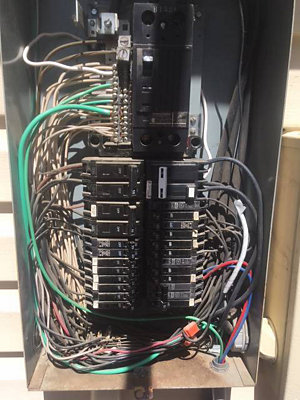How Much Does It Cost to Upgrade an Electrical Panel in Colorado?

Upgrading your home's electrical panel is an important project that can improve safety, increase capacity for modern appliances, and enhance your home's value. This guide will explore the various factors that influence the overall cost of an electrical panel upgrade.
Several factors affect the final cost of upgrading an electrical panel:
- The size of the new panel
- Whether or not trenching is needed
- Whether whole-home rewiring is needed
- Additional outlets/fixtures
- Whether the utility company requires a new meter
- Whether you have overhead or underground service lines
- Labor
Let’s discuss those factors and how they affect the final price of your electrical upgrading.
Price factor #1: The size of the new panel
Electrical panels are sized in “amperage”, which measures the strength of the electric current that the panel sends into your home. Residential panel sizes can range anywhere from 100 to 400 amps.
Most homes built today have either 100-amp or 200-amp panels. The minimum required by the National Electric Code (NEC) is a 100-amp panel. But if your home was built in or before the 1960s, your home may have a very outdated 60-amp panel.
Our suggestion? If you’re considering upgrading your home’s main panel and you have a 60-amp or 100-amp, upgrade to at least a 200-amp panel. A 200-amp panel can satisfy the electrical load of most residences and their modern electronics.
Not sure what size panel you currently have? You can sometimes determine the size by checking the amperage rating of the main breakers. If you still aren’t sure what size panel you have, contact an electrician. They’ll be able to determine the panel amperage by the size of your home’s wiring.
Price factor #2: Whether or not trenching is needed
Every main electrical panel, regardless of size, is fed power from the utility lines via electrical lines that are either underground or overhead. Those lines are designed to match the amperage of your panel. So, when you upgrade to a larger panel size, you’ll most likely need to replace those lines. And if you have underground service lines, this will involve trenching.
The length of those electrical lines and ease of accessibility determine how much extra the trenching will cost.
Price factor #3: Whether or not whole-home rewiring is needed
Unfortunately, if you have an outdated 60-amp panel and are upgrading your electrical panel, you’ll need to update your home’s electrical wiring as well. That’s because the wiring in your home is likely:
- Old, frail and faulty wiring
- Not designed to handle the higher amperage of your new panel
(Spoiler alert: Both of these problems can cause a disastrous electrical fire!)
In many instances, even an upgrade from a 100-amp panel to a 200-amp panel will warrant some rewiring. If you’re not sure whether your panel upgrade requires whole-home rewiring, contact an electrician. They’ll look at your current electrical system and determine whether the wiring can handle the upgraded amperage.
Price factor #4: Adding outlets
If you have an older home with an outdated electrical panel, it’s also very likely that there aren’t enough outlets to keep the home up to code. The NEC (National Electric Code) states that an outlet should be installed per every 12 feet of wall.
A good electrician will inspect your home to determine whether outlets need to be installed to keep the house up to code.
Price factor #5: Whether the utility company requires a new meter can
Sometimes, your local utility company will require a new lever bypass meter enclosure. A new device to keep technicians safe while working on your meter.
Price factor #6: Whether it is an overhead or underground service
As we mentioned in price factor #2 (trenching), every home’s main electrical panel is fed power via utility service lines. Now, in Colorado, those service lines either run underground or overhead.
Typically, if you have overhead service lines, your panel upgrade will cost more than if you have underground service lines (unless trenching is required). That’s because overhead service line changes require more time and labor.
Price factor #7: The electrician/contractor you choose
Here’s the bottom line: The higher the quality and the more experience an electrician or contractor has, the more they typically charge for their services. But paying more for a quality electrician will save you money in the long run and will keep your home and family safe.
You wouldn’t choose a brain surgeon who offers rock bottom prices, right? The same logic should apply to the electrician you choose to upgrade your home’s electrical system. Sloppy or inexperienced work will quickly result in many needed repairs or worse—an electrical fire.
Our suggestion is to choose an electrician who:
- Is licensed and insured in the state of Colorado
- Has vast experience in panel upgrades
- Has been in business for at least 5-10 years
- Has good reviews on BBB (Better Business Bureau) and Yelp
Need help from a Colorado Plumbing, Heating, Cooling, or Electrical Specialist?
For your convenience, you can request an appointment in one of two ways:
- Call us at (303) 436-2525 for immediate assistance.
- Click on the button below to schedule your appointment online.
Related Reading
Join Our Email Newsletter
Receive updates, current news, promotions, and industry tips.
